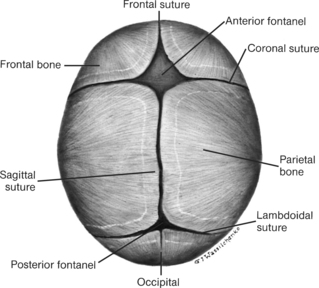Chapter 11. Head and Neck
Rationale
Examination of the head and neck is important in screening pediatric clients for acute disorders and long-term disabilities. The determination of disorders such as skull asymmetry can also signal the need for parent teaching.
Anatomy and Physiology
The head accounts for one fourth of the body length and one third of the body weight in the newborn infant, in comparison with one eighth of the body length and one tenth of the body weight in the adult. Head size, which is 32 to 38 cm (12.6 to 14.9 inches) at birth, normally exceeds chest circumference by 1 to 2 cm (0.4 to 0.8 inches) until 18 months of age. After 18 months, chest growth exceeds head size by 5 to 7 cm (2 to 2.76 inches) (see Appendix B for charts of head circumference norms). The newborn skull consists of separate bones that fuse when brain growth is complete. Soft, fibrous tissue joints, called sutures, separate the bones (Figure 11-1). Sutures begin to unite by 6 months of age but can be separated by increased intracranial pressure until 12 years of age.
 |
| Figure 11-1Location of sutures and fontanels.(From Hockenberry MJ et al: Wong’s nursing care of infants and children, ed 7, St Louis, 2003, Mosby.)Elsevier Inc. |
Fontanels are formed by the juncture of three or more skull bones (see Figure 11-1) and are felt as soft concavities. Although there are several fontanels (sagittal or parietal, sphenoidal, mastoid, anterior, and posterior), normally only the posterior and anterior fontanels can be palpated. The sagittal fontanel, located between the anterior and posterior fontanels and along the sagittal suture, can be palpated in some neonates and in some infants with Down syndrome. The posterior fontanel might be closed at birth and should always be closed by the second month. The anterior fontanel closes between 9 and 26 months of age; 90% close between 7 and 19 months.
By 4 months of age the infant should be able to hold the head erect and in midline. By 6 months no significant head lag should be noted when the child is pulled to a sitting position.
The neck in the infant and toddler is short, but by 4 years of age it assumes adult proportions. Although the thyroid gland is fully active at birth, it might not be palpable in infants and young children.
▪ Paper or narrow flexible metal tape (not cloth tape, which can stretch)
| Measurement | Findings | ||
|---|---|---|---|
| Measure head circumference if the child is 2 years of age or younger, if the size of the child’s head warrants concern, or if there is possible concern about neurologic or developmental health issues. Place the tape around the head at points just above the eyebrows and the pinna and around the occipital prominence (Figure 11-2). If head circumference is measured daily, the head should be marked at key points to ensure consistency of measurement. Head circumference should be plotted on gender-specific charts. If the infant is premature, then the age of the infant should be corrected for prematurity and the head circumference plotted by conceptual rather than chronologic age. |
Head circumference provides an estimate of cranial volume, which reflects brain size and correlates with neurologic and developmental functions. The head can appear disproportionately large (but normal) in infants born prematurely or in children whose familial pattern exhibits large heads.
Clinical Alert
If an infant’s head circumference is above or below growth norms for the infant’s established percentile, further evaluation is indicated. An abnormally large head circumference can indicate hydrocephalus, brain tumor, cerebral gigantism, neurofibromatosis, hemorrhage, or autism. A small head circumference can indicate craniostenosis or microcephaly. Infants born to mothers who use cocaine or alcohol or who experienced intrauterine infection can have smaller head circumferences.
|
Preparation
Sit or lay the child in a comfortable position. The infant or young child might be most at ease on the parent’s lap.
Assessment of Head
| Assessment | Findings |
|---|---|
| Observe the shape and symmetry of the child’s head from different angles. If possible, also note the shape and symmetry of the parents’heads. Part the hair of the child and inspect for lesions or masses. |







